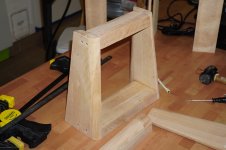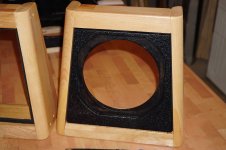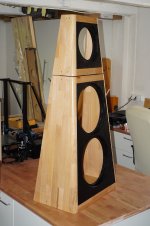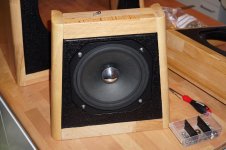Hi all,
I'm considering to build a DIY OB using a full range driver together with one or two Peerless SLS 315 (12 inch) drivers per channel. I already own 4 Peerless SLS 12 drivers in total and I'm wondering if these would make a good OB canditate together with a 6 to 8 inch full range driver?
For instance a TangBand W8-2145, or a Lii audio Silver-8 driver. The latter has a rather low Qts by the way, not sure if that would suit a OB, although I've seen this driver in an OB configuration.
I'm considering to build a DIY OB using a full range driver together with one or two Peerless SLS 315 (12 inch) drivers per channel. I already own 4 Peerless SLS 12 drivers in total and I'm wondering if these would make a good OB canditate together with a 6 to 8 inch full range driver?
For instance a TangBand W8-2145, or a Lii audio Silver-8 driver. The latter has a rather low Qts by the way, not sure if that would suit a OB, although I've seen this driver in an OB configuration.
The peerless SLS315 is a known driver for open baffle, there are threads on it here at diyaudio, eg https://www.diyaudio.com/community/threads/2-way-passive-open-baffle.239558/ combining it with a FR has been done quite a lot of times, so you will probably find plenty of examples.
Qts is only relevant around Fs, so not so much for the fullrange driver on top.
With a DSP active crossover (like miniDSP), a measuring microphone, some channels of amplification you can do a lot already. I wanted to add a wooden board with holes, but you can also just hang the speakers for an initial impression (and maybe even better results).
Qts is only relevant around Fs, so not so much for the fullrange driver on top.
With a DSP active crossover (like miniDSP), a measuring microphone, some channels of amplification you can do a lot already. I wanted to add a wooden board with holes, but you can also just hang the speakers for an initial impression (and maybe even better results).
@ErikdeBest: thanks for your response and suggestions and link!
The 4" Mark Audio CHR-70 seems like an intersting driver, as it is affordable, only 40 euro's per driver. Any idea how this compares to more expensive full range drivers like for instance the Tang Band W8-1772 which is about 8-10 times more expensive? The latter one has much higher sensitivity and a bit more LF extension, which are both not really important as the Peerless SLS 315 will do that area...
The 4" Mark Audio CHR-70 seems like an intersting driver, as it is affordable, only 40 euro's per driver. Any idea how this compares to more expensive full range drivers like for instance the Tang Band W8-1772 which is about 8-10 times more expensive? The latter one has much higher sensitivity and a bit more LF extension, which are both not really important as the Peerless SLS 315 will do that area...
If you have woofers on your OB, almost any FR can be a midTweeter.
Unless you need to play very loud i would suggest 4”: is the sweet spot. Pluvia 7HD is a step up from CHR70 for not a whole lot more money.
I wouldn’t go anywhere near the Lii Audio stuff.
dave
Unless you need to play very loud i would suggest 4”: is the sweet spot. Pluvia 7HD is a step up from CHR70 for not a whole lot more money.
I wouldn’t go anywhere near the Lii Audio stuff.
dave
Last edited:
The best thing would be to try several ones, as it really depends on the taste and the sonic signature.
I had (modified) Visaton B200 on OB (With Eminence Beta 15 woofers, biamped).
Now I have something different, bass in a box and I am still experimenting with various FR.
As Dave said, almost any FR can be a midtweeter.
If you go active, it is much easier as you don't have to worry about matching efficiencies (or use L pads).
So, in my experience, I found that I prefer 8" or so in the Open Baffle as a fullrange. But you may prefer a smaller one. You have to try for yourself, until you find one that you like.
I had (modified) Visaton B200 on OB (With Eminence Beta 15 woofers, biamped).
Now I have something different, bass in a box and I am still experimenting with various FR.
As Dave said, almost any FR can be a midtweeter.
If you go active, it is much easier as you don't have to worry about matching efficiencies (or use L pads).
So, in my experience, I found that I prefer 8" or so in the Open Baffle as a fullrange. But you may prefer a smaller one. You have to try for yourself, until you find one that you like.
@Vix: thanks for the suggestions! I Guess I will try different drivers then...
Hi, I tried to do some simuations using Basta Edge. I'm a newbie to this subject, I used Hornresp in the past to calculate power response for OB woofers.
If I'm correct, for simulating mid / tweeter driver response, I need Edge, and for LF power response I can use for instance Hornresp, which is accurate to the frequency where directivity starts.
So I started simulating a 4 inch (60mm cone diameter?) driver in a 400x1000mm open baffle. I dragged the driver on the baffle surface until I got a good looking frequency response. Not sure if phase response looks ok by the way? I would like to cross over somewhere in between 200 - 500 Hz, as the SLS 315 is more suited for LF.

Hi, I tried to do some simuations using Basta Edge. I'm a newbie to this subject, I used Hornresp in the past to calculate power response for OB woofers.
If I'm correct, for simulating mid / tweeter driver response, I need Edge, and for LF power response I can use for instance Hornresp, which is accurate to the frequency where directivity starts.
So I started simulating a 4 inch (60mm cone diameter?) driver in a 400x1000mm open baffle. I dragged the driver on the baffle surface until I got a good looking frequency response. Not sure if phase response looks ok by the way? I would like to cross over somewhere in between 200 - 500 Hz, as the SLS 315 is more suited for LF.
I’d run the SLS15 right up to 800hz with the top woofer and add a .5 inductor to the second somewhere around 200hz. The major breakup on the SLS isn’t until 2k so now worries at all crossing high at 800. Using 12” woofers instead of 15 or 18 affords you this luxury……take it. Now you have a lot more choices on the mid tweeter/FR. SS 10F will have much better off axis response with it‘s smaller diameter cone and thermally, the 10f will hold out longer than the SLS15’s so power handling is no longer an issue
Truth……unless your room is tiny, no OB system will give you useful LF response below 50hz so plan on a small sub with a high Q to supplement down low…..with 12’s likely a 40hz crossover will do the trick. Two would be better……and 4 would be the ultimate with one out of phase unit. Honestly at that point, you could cross much higher and eliminate the need for 2 12’s per side as the in room LF response at and below Schroeder would be smooth as silk. Since you have 4 12’s on hand, if you have the wood and the time, I suggest you prove the theory for yourself……build those into 4 sealed boxes of 3ft tuned to 30hz and spread em around your room……..but be warned, you’ll be ruined forever.
Truth……unless your room is tiny, no OB system will give you useful LF response below 50hz so plan on a small sub with a high Q to supplement down low…..with 12’s likely a 40hz crossover will do the trick. Two would be better……and 4 would be the ultimate with one out of phase unit. Honestly at that point, you could cross much higher and eliminate the need for 2 12’s per side as the in room LF response at and below Schroeder would be smooth as silk. Since you have 4 12’s on hand, if you have the wood and the time, I suggest you prove the theory for yourself……build those into 4 sealed boxes of 3ft tuned to 30hz and spread em around your room……..but be warned, you’ll be ruined forever.
@mayhem: thanks for your suggestions! I was thinking the Peerless SLS 315 usable frequency range would be to around 500 Hz, but if I'm correct, it is usable up to 800Hz? Not sure if sound quality in this upper range (300 - 800 Hz) is still ok?
The advantage of a bigger full range driver like the Tangband W8-2145 for instance would be that I have the ability to cross it over at a lower frequency which seems interesting to me.
The advantage of a bigger full range driver like the Tangband W8-2145 for instance would be that I have the ability to cross it over at a lower frequency which seems interesting to me.
Read MJK’s OB baffle article. Where the XO is best placedis also quite dependent on the baffle shape (width in particular).
http://www.quarter-wave.com/OBs/OB_Theory.html
dave
http://www.quarter-wave.com/OBs/OB_Theory.html
dave
Sonido SWR175.
A whole new price league than the Markaudios. One of the higher end driver makers still selling direct. Note that when Cube went from direct to distributors prices close to tripled.
I have not heard (or seen) any of these, but the 6x9 is of particualr interest. If the reviews hold any water, these drivers are good value. Didn’t stop us from doing soe boxes.

dave
Hi Lynx,
2 Peerless 12" are a good solution for bass, but from my experience a 7" or 8" FR is needed to remain in balance, smaller units will sound small and won´t do the required dynamics. Around 300Hz or 400Hz is a good crossover point, it works well. Make the bass part of the baffle large, the FR part small. A nice design is a trapezoid baffle, which is not too complicated, but gives good results (I may be allowed to attach some pictures). Be prepared to invest in a microphone and to learn how to make measurements. A passive filter is possible. DSP filter is also possible, but I´d shy away from cheap dsp solution and especially low quality adc´s and dac´s.
I still have a few pairs of Visaton B200, a pair of TB 1808 and an unused pair of Satori MR 16 in the bin, should you be interested in anything for a good price, write a PM.
Groetjes
Mattes

 .
. 


2 Peerless 12" are a good solution for bass, but from my experience a 7" or 8" FR is needed to remain in balance, smaller units will sound small and won´t do the required dynamics. Around 300Hz or 400Hz is a good crossover point, it works well. Make the bass part of the baffle large, the FR part small. A nice design is a trapezoid baffle, which is not too complicated, but gives good results (I may be allowed to attach some pictures). Be prepared to invest in a microphone and to learn how to make measurements. A passive filter is possible. DSP filter is also possible, but I´d shy away from cheap dsp solution and especially low quality adc´s and dac´s.
I still have a few pairs of Visaton B200, a pair of TB 1808 and an unused pair of Satori MR 16 in the bin, should you be interested in anything for a good price, write a PM.
Groetjes
Mattes
 .
. 


Last edited by a moderator:
@Mattes: thanks for your respone and nice pictures, the build quality looks very nice! I still have to decide what to do: go for a smaller (for instance 4 inch) FR driver, or a larger one like 8 inch. If I get interested in your drivers I'll contact you!
After reading al the responses in this thread, and reading the articles by Martin J. King, I got many questions because of limited knowdledge and experience...
My first question is: why would one put the full range driver (mid / upper FR) in a smaller baffle area? When I do some simulations in Edge, and I compare a smaller baffle like 150x200mm to a larger one of 400x1000mm, and in both cases I position the FR driver at the top right corner, the larger baffle gives a more extended LF response and better phase response.
I just looked for affordable 8 inch FR drivers, and found the SB acoustics sb20frpc30-8 to be interesting:
https://www.diyaudio.com/community/...frpc30-8-8-fullrange-cheap-monster-ii.385062/
maybe it's not a high end driver, but interesting to experminent and start with?
After reading al the responses in this thread, and reading the articles by Martin J. King, I got many questions because of limited knowdledge and experience...
My first question is: why would one put the full range driver (mid / upper FR) in a smaller baffle area? When I do some simulations in Edge, and I compare a smaller baffle like 150x200mm to a larger one of 400x1000mm, and in both cases I position the FR driver at the top right corner, the larger baffle gives a more extended LF response and better phase response.
I just looked for affordable 8 inch FR drivers, and found the SB acoustics sb20frpc30-8 to be interesting:
https://www.diyaudio.com/community/...frpc30-8-8-fullrange-cheap-monster-ii.385062/
maybe it's not a high end driver, but interesting to experminent and start with?
Last edited:
Hi, after reading the articles by M.J. King a got a lot of new questions, not sure where I can find the answers:
- how does one simulate, and should one simulate, the floor bouncing effect?
- does one need to simulate / integrate / merge real frequency repsone of the specific driver with the simulated baffle response?
- how about Edge phase response: when changing position of the simulated driver in an open baffle, both frequency and phase response change. Are there any rules when it comes to phase response, as one has to add a cross over as well and integrate the woofer with a FR driver?
- sometimes I see just one large baffle, like the rectengular baffle in the article of M.J. King, 20 x 38 inch. But sometimes I see (and read) about mid / upper range drivers which are mounted in a smaller (narrower) baffle, compared to the wider bass driver baffle. When using Edge to simulate frequency response, I can't see a better frequency respone when using a narrower baffle for the FR driver. So what would be the advantage of a narrower baffle over a wider baffle for mid / high frequencies? Also what would be the advantage of a tapered or rounded baffle compared to a simple rectangular shape? The only thing I can come up with is a more gradual LF dipole cancellation?
There are two distinct ways of thinking here where OB is concerned……MJKs wide baffle simulations vs Sigfried Linkwitz narrow or odd shaped baffle. There‘s supporting work and research from both available as well as the subjective responses of thousands who‘ve built their systems along either guidelines.
As far as I can say, the difference lies in what what many like to call diffraction…..and that’s essentially sound emanating from the driver that reflects off of surfaces like the driver surround, mounting flange, baffle, edges and cabinet (if any) sides. One camp believes that all diffraction is negative and calls attention to its presence in a 3D environment while others will say that only edges and corners are a source of ‘objectionable’ diffraction.
My personal observations over decades has led me to one obvious conclusion……narrow baffles image better….period! Remember that there’s always compromises when it comes to a speaker and this is where the realm of pure subjectivity comes into view. The objective data suggests quite a lot based on the collection of individual listening experience and preference over decades of research. But at the end of the day, this can and only will be tainted with inherent flaws of bias (many types), preference and the not so fully understood ear/brain mechanism. In other words, there is NO CONTROL group for a sound scientific outcome.…..nor is there any viable reference when it comes to the content of recorded music as well as the countless environmental variables.
For me, the larger the object in a 3D space, the more it calls attention to itself as being an obstruction to overall wavefront….it’s not the small but angular reflections that ripple the response 1-2db( the sighted listening measuring clan take note) but the overall room interaction at play…..our ear/ brain mechanism of location…..as poor as it is for us humans when compared to the rest of the animal kingdom, in its evolutionary function it still exists……it’s acuity is dependent of how often you use or exercise it. This is precisely where audiophilea gets into trouble……a cult of shared preferences where one believes so profoundly in their abilities to be ‘better’ that it demands exclusivity or cult like status.
The ONE response that rings true though across all listening experience is that speakers sound BETTER when they’re not in a box……that’s lead you here. The rest of it, how the wavefronts react and compete in a 3D space?….well…..that’s more an apples and oranges kinda thing. Just ask the tens of thousands of Magnepan owners.
As far as I can say, the difference lies in what what many like to call diffraction…..and that’s essentially sound emanating from the driver that reflects off of surfaces like the driver surround, mounting flange, baffle, edges and cabinet (if any) sides. One camp believes that all diffraction is negative and calls attention to its presence in a 3D environment while others will say that only edges and corners are a source of ‘objectionable’ diffraction.
My personal observations over decades has led me to one obvious conclusion……narrow baffles image better….period! Remember that there’s always compromises when it comes to a speaker and this is where the realm of pure subjectivity comes into view. The objective data suggests quite a lot based on the collection of individual listening experience and preference over decades of research. But at the end of the day, this can and only will be tainted with inherent flaws of bias (many types), preference and the not so fully understood ear/brain mechanism. In other words, there is NO CONTROL group for a sound scientific outcome.…..nor is there any viable reference when it comes to the content of recorded music as well as the countless environmental variables.
For me, the larger the object in a 3D space, the more it calls attention to itself as being an obstruction to overall wavefront….it’s not the small but angular reflections that ripple the response 1-2db( the sighted listening measuring clan take note) but the overall room interaction at play…..our ear/ brain mechanism of location…..as poor as it is for us humans when compared to the rest of the animal kingdom, in its evolutionary function it still exists……it’s acuity is dependent of how often you use or exercise it. This is precisely where audiophilea gets into trouble……a cult of shared preferences where one believes so profoundly in their abilities to be ‘better’ that it demands exclusivity or cult like status.
The ONE response that rings true though across all listening experience is that speakers sound BETTER when they’re not in a box……that’s lead you here. The rest of it, how the wavefronts react and compete in a 3D space?….well…..that’s more an apples and oranges kinda thing. Just ask the tens of thousands of Magnepan owners.
Last edited:
Thanks again for the replies and suggestions! I think you are correct: I use some simulations and hope to get some basic understanding and rough design, and fine tune by trail and error, practical experimentation. I have installed both hornresp and Edge to be able to make some simulations.
Maybe I should try different drivers, and one name I came across is Lii Audio, like this driver:
https://lii-audio-europe.com/product/speakers/fast-8/
Any experience and ideas about this driver? I've never heard of this manufacturer, do they produce well made quality drivers?
Maybe I should try different drivers, and one name I came across is Lii Audio, like this driver:
https://lii-audio-europe.com/product/speakers/fast-8/
Any experience and ideas about this driver? I've never heard of this manufacturer, do they produce well made quality drivers?
- Home
- Loudspeakers
- Full Range
- DIY full range OB